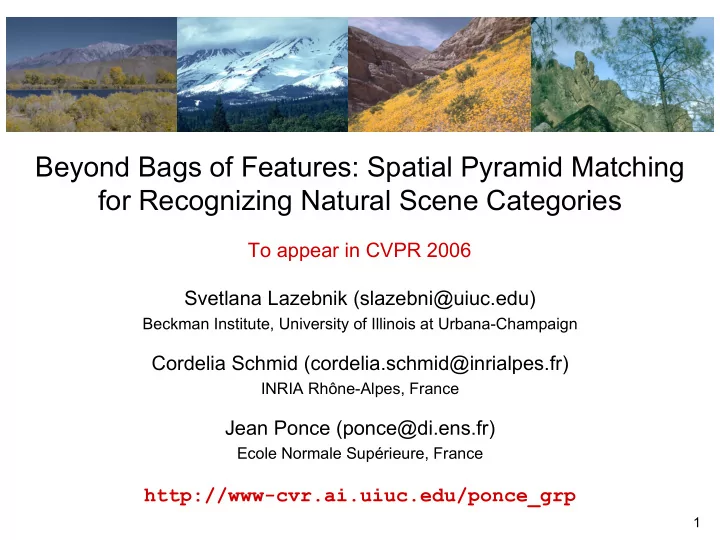

Beyond Bags of Features: Spatial Pyramid Matching for Recognizing Natural Scene Categories To appear in CVPR 2006 Svetlana Lazebnik (slazebni@uiuc.edu) Beckman Institute, University of Illinois at Urbana-Champaign Cordelia Schmid (cordelia.schmid@inrialpes.fr) INRIA Rhône-Alpes, France Jean Ponce (ponce@di.ens.fr) Ecole Normale Supérieure, France http://www-cvr.ai.uiuc.edu/ponce_grp 1
Overview • A “pre-attentive” approach: recognize the scene as a whole without examining its constituent objects Biederman (1988), Thorpe et al. (1996), Fei-Fei et al. (2002), Renninger & Malik (2004) • Inspiration: locally orderless images Koenderink & Van Doorn (1999) • Previous work: “subdivide-and-disorder” strategy Szummer & Picard (1997) SIFT: Lowe (1999, 2004) Gist: Torralba et al. (2003) 2
Spatial pyramid representation • Extension of a bag of features • Locally orderless representation at several levels of resolution • Based on pyramid match kernels Grauman & Darrell (2005) – Grauman & Darrell: build pyramid in feature space, discard spatial information – Our approach: build pyramid in image space, quantize feature space level 0 level 1 level 2 3
Pyramid matching Indyk & Thaper (2003), Grauman & Darrell (2005) Find maximum-weight matching (weight is inversely proportional to distance) Original images Feature histograms: Level 3 Level 2 Level 1 Level 0 Total weight (value of pyramid match kernel ): 4
Feature extraction Strong features Weak features Edge points at 2 scales and 8 orientations SIFT descriptors of 16x16 patches sampled (vocabulary size 16) on a regular grid, quantized to form visual vocabulary (size 200, 400) 5
Scene category dataset Fei-Fei & Perona (2005), Oliva & Torralba (2001) http://www-cvr.ai.uiuc.edu/ponce_grp/data Multi-class classification results (100 training images per class) Fei-Fei & Perona: 65.2% 6
Scene category retrieval Query Retrieved images 7
Scene category confusions Difficult indoor images kitchen living room bedroom 8
Caltech101 dataset Fei-Fei et al. (2004) http://www.vision.caltech.edu/Image_Datasets/Caltech101/Caltech101.html Multi-class classification results (30 training images per class) 9
Caltech101 comparison Zhang, Berg, Maire & Malik, 2006 our method 10
Caltech101 challenges Top five confusions Easiest and hardest classes • Sources of difficulty: lack of texture, camouflage, “thin” objects, highly deformable shape 11
Graz dataset Opelt et al. (2004) http://www.emt.tugraz.at/~pinz/data/ Detection results (100 pos./100 neg. training images) bag-of-features methods • Global spatial regularities (natural scene statistics) help even in databases with high geometric variability! 12
Recommend
More recommend